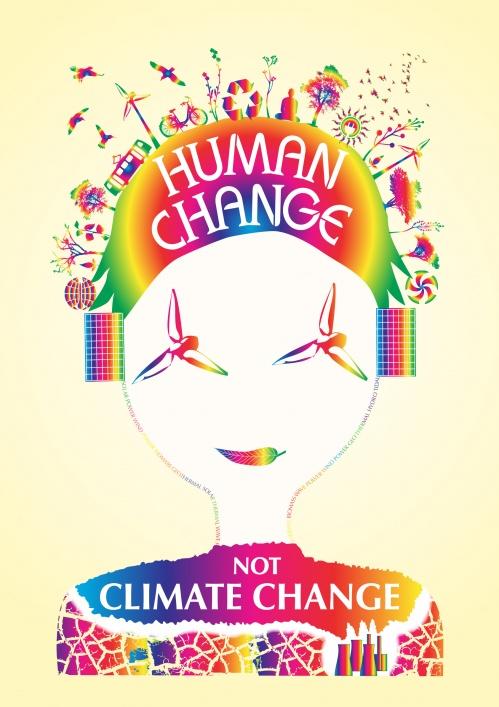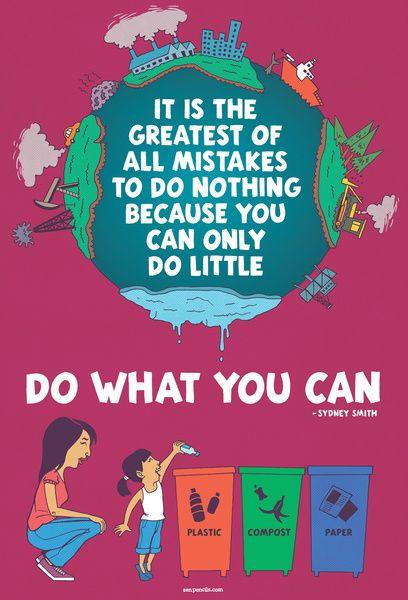It is possible to presume that the visual materials may largely support the contemporary initiatives for the achievement of climate sustainability. Images on the ecological issues aim to encourage the ecologically friendly behavior and raise awareness of the topical problems. When arguments are visually supported, it becomes easier to comprehend and remember them.
The images which will be analyzed in the essay are the posters illustrating the issues associated with the climate change, e.g., the role of a person in this process, and possible ways to improve the situation. The posters “Human Change, Not Climate Change” and “Do What You Can” convey the idea that every individual can favorably influence the environment and that every substantial progress starts with a small step.
“Human Change, Not Climate Change” Poster
It is evident that the human activity is hazardous for the climate. Transportation, production processes, extraction of natural resources, etc. influence the environment every day. To prevent the severe damages, the global community should undertake measures to control various human activities. The most effective way to deal with climate change is mitigation of risks (Chen et al. V). The solutions recommended by scholars and scientists include the regulation and limitation of fossil fuels use, as well as the research and development of alternative sources of energy (Lefebvre et al. 6). However, it is possible to say that since the environmentally harmful activities constitute a significant part of the current mode of life, the substantial changes in the human consciousness and worldview are first required. The poster “Human Change, Not Climate Change” addresses this idea. It shows why it is essential to prevent climate change. The author and the publication date of the poster were not indicated. It uses specialty fonts in both inscriptions which suit the color scheme. All capital and bold letters are used. The large font is intended to attract the attention of viewers.

The placement of the text is meaningful, i.e., the phrase “Human Change” basically points at the mind, the area where the changes must occur. The color used in the poster is probably the most important element of this visual argument. The image is created in the colors of the rainbow which symbolize promise and enlightenment. Therefore, the colors make a positive impression and instill the belief in a favorable outcome. The major visual element is a semi-abstract face with the incorporated shapes of various alternative energy sources. For instance, wind turbines are used as eyes, and a leaf is depicted instead of the mouth. The solar batteries make the ears, while the hair looks like the surface of the Earth covered with trees and inhabited by birds and plant species. At the same time, wind turbines, and ecological transportation modes represent the sustainable human activities. Lastly, there is a person sitting in the middle of the head in the Buddha posture which symbolizes the human in the sublime, relaxed, and auspicious state of mind. The upper text, “Human Change,” is semantically opposed to the phrase “Not Climate Change” put in the lower part. The latter is placed in the cloud of the smoke coming out of the factory pipes. It seems that the visual pattern in this area forms a garment. In this way, the text may indicate that the efforts which target the external side of the problem are superficial and, therefore, may not be very efficient. For better results, the inner transformation is required. Overall, the visual and textual contrasts identified in the poster can be easily read by viewers. Moreover, they create an emotional and intellectual appeal which may help to address the issue in an effective way.
“Do What You Can” Poster
Although it is considered that adverse human activities contribute to the deterioration of the environmental condition, the climate change may also be a result of human inactivity. Based on this, the promotion of ecologically friendly practices should always commence at the local level (Uitto et al. 25). Every community should be aware of its main environmental problems and undertake efforts to improve the situation. For instance, the industrialized and advanced societies should pay attention to the issue of overconsumption and its impact on the environment (Crate and Nuttal 271). The reduction in consumption rates may have a good effect. Nevertheless, the fact that most people do not believe in own capabilities to make any impact poses the major issue. And the second poster “Do What You Can” by Sydney Smith strives to attract the public attention to this side of the problem.
The poster inscriptions are bold and capitalized. There are two pieces of text, and they are both located in the middle. The author uses the complementary and semi-complementary colors which make the visual elements distinctive and well-contrasted to the background and each other. The poster shows how various attributes of human activities such as oil derricks, cars, factories, etc. influence the ecological state. We see the smoke coming out of the pipes and the pile of garbage floating in the water. However, the major detrimental effect is the melting of the Antarctic ice. Smith played around this idea by placing the Antarctica at the bottom of the Earth and showing how the drops of the melted water are running down. At the lower part of the poster, a woman and a girl near three wastebaskets are depicted. The girl throws the garbage into the waste-separation baskets, and it seems that the woman approves her behavior. Thus, not only the image transfers the risk information about the climate change but also reveals the significance of education and encouragement.
The upper inscription appeals to everyone to do at least what one can. Separating waste is a little thing but, in the long run, it may lead to big results.

The above image is an encouraging poster “Do What You Can.”
The explicit message of this poster is evident. It encourages to do little everyday things to help the planet. It shows that the involvement of every person is important, no matter how young or old he or she may be. The image of the polluted Earth implicitly conveys the information about potential risks and threats of climate change. It shows what possible outcome of the human activity may be unless people change their conduct.
Summary
Both posters address the problem of climate change but approach it from the different sides. The first poster focuses on the potential positive outcomes which may be achieved in case people change themselves. It presents a bright image of a safe place for living, where individuals use alternative sources of energy and perform ecologically friendly practices. The second poster pays greater attention to the negative consequences of human activities. It encourages individuals to intervene their habits to improve their life and protect the planet.
It is possible to conclude that both of the posters are efficient in their ways. While the first may be considered more creative, the second one is more literal and clear. The incorporation of multiple graphic objects and symbols related to the topic, as well as the slight touch upon the negative aspects of the climate change, makes them similar to some extent. However, the implications of the selected works are far not the most aggressive and negative. For instance, the rainbow colors in the first image rather create a cheerful and hopeful atmosphere.
Both images call for actions. They encourage people to become different to sustain the Earth. It is possible to say that they are aimed to address the broad audience. They effectively attract the attention of viewers to the topical environmental problems and provoke reflection on them.
Works Cited
Chen, Wei-Yin, et al., editors. Handbook of Climate Change Mitigation and Adaptation. 2nd ed., Springer, 2017.
Crate, Susan A., and Mark Nuttall. Anthropology and Climate Change: From Encounters to Actions. Routledge, 2016.
“Do What You Can.” Thinglink, (n.d.), Web.
“Human Change, not Climate Change.” Posters for Good, (n.d.), Web.
Lefebvre, Gilles, et al., editors. Environment, Energy and Climate Change II: Energies from New Resources and the Climate Change. Springer, 2016.
Uitto, Juha I., et al., editors. Evaluating Climate Change Action for Sustainable Development. Springer Open, 2017.